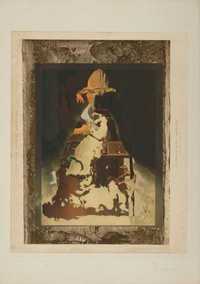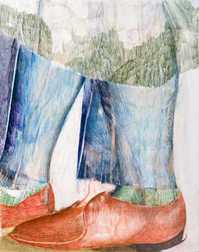For several weeks, I’ve been posting Joseph Mills’ photos, here and here. I discovered him only recently. Using a cheap camera, he brings new meaning to concept of depth of field.
 I owe the intro to Ambach & Rice, currently featuring an exhibit of Mills’ collaged and silkscreened unique book pages, titled Anarch. Unlike the photos, which are in Kafka’s famous phrase, “an ax for the frozen sea within us,” the prints (click to enlarge example) have a density that resists connection.
I owe the intro to Ambach & Rice, currently featuring an exhibit of Mills’ collaged and silkscreened unique book pages, titled Anarch. Unlike the photos, which are in Kafka’s famous phrase, “an ax for the frozen sea within us,” the prints (click to enlarge example) have a density that resists connection.
Plus, they’re small and require visual burrowing. It’s easier to keep walking and yet, certain I was heading out the door, I kept doubling back to see them again.
In each, a burning monk and a frog laid on its back, as if on a high-school biology dissection table, open into a changing collage of art history’s high points. Both frog and monk appear to be eating their way through the cannon, like moths in a closet full of matching skirts and sweater sets.
As quoted in the press release, Mills considers himself a latter day Surrealist:
Surrealism didn’t
resolve my concerns about meaning and meaninglessness, but it did address the infinite,
mysterious and subconscious; that was really enough.
Also at A&M are the figurative, colored pencil drawings of Christian Weibrauch. If Mills is corrosively reductive, Weibrauch (click image to enlarge) is dreamily additive.
 Down on their luck, our forests have hit the road as homeless people. Their ankles are thick from bad food, and their shoes have no laces. In other drawings, a figure is a world within a world containing worlds – in the artist’s words, “moving on the edge of an osmosis.”
Down on their luck, our forests have hit the road as homeless people. Their ankles are thick from bad food, and their shoes have no laces. In other drawings, a figure is a world within a world containing worlds – in the artist’s words, “moving on the edge of an osmosis.”
Weibrauch is dangerously close to cute, close to illustrations in children’s books. If that quality could be thought of as an edge, he doesn’t fall off it. Instead of whimsical, there’s a slow-motion, tidal pull inward. Art comes and goes, but by rooting fantasy in a tender, elegaic realism, these drawings have no real pull date.
Mills and Weibrauch continue through April 19.This is the first exhibit of Mills’ silkscreens and Weibrauch’s first exhibit in the U.S.



Leave a Reply